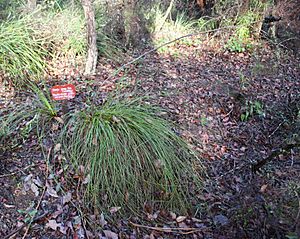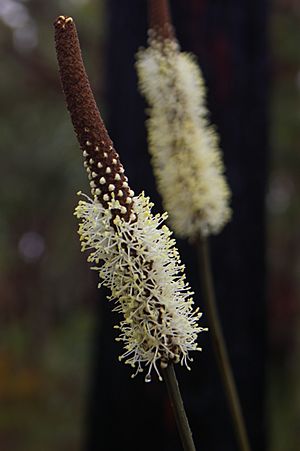Graceful grasstree facts for kids
Quick facts for kids Graceful grasstree |
|
|---|---|
 |
|
| Xanthorrhoea gracilis at the Bridgetown Jarrah Park | |
| Scientific classification |
The Xanthorrhoea gracilis, often called the graceful grasstree, grassboy, or mimidi, is a special type of grasstree. It belongs to the Xanthorrhoea family and grows naturally in Western Australia.
Contents
What is a Graceful Grasstree?
This amazing plant is a type of grass tree that grows in clumps. It usually reaches about 2 metres (7 ft) tall. It doesn't have a visible trunk above ground. Instead, it sends up a long stalk, called a scape, which can be about 1.5 metres (4.9 ft) long. On top of this stalk, a flower spike grows to about 0.2 metres (1 ft).
The graceful grasstree blooms between October and January. Its flowers are a lovely cream-white color. Even though you can't see a stem, branches grow underground. The plant can have one main clump of leaves or many. These clumps look like loose, upright tufts of grass.
Its long, thin green leaves are about 1.5 metres (4.9 ft) long. They are usually about 3 millimetres (0.12 in) wide and 1.5 mm (0.06 in) thick. The leaves are a bit hairy near their base.
How it Got its Name
A botanist named Stephan Endlicher first officially described this plant in 1846. He included it in a book called Irideae. Plantae Preissianae by Johann Georg Christian Lehmann.
The X. gracilis is a close relative of another grasstree. This one is called Xanthorrhoea macronema and it grows in eastern Australia.
Where Does it Live?
You can find the graceful grasstree along the west coast of Western Australia. It lives in areas like the Wheatbelt, Peel, and South West regions. It also grows along the south coast into the Great Southern region.
Its home stretches from Carnamah in the north down to Plantagenet in the south-east. It prefers to grow in sandy-loamy soils that have lateritic gravel.
This grasstree is often found in the jarrah forest ecosystem. It grows as part of the plants that live under the taller trees. Some of the tall trees it grows near include Eucalyptus marginata, E. calophylla, and Allocasuarina fraseriana. Other plants found nearby are Banksia grandis, Persoonia elliptica, and P. longifolia. You might also see plants like Anigozanthos humilis, Grevillea wilsonii, and Hakea amplexicaulis growing with it.
Growing and Surviving
You can grow the graceful grasstree from its seeds. It likes to grow in a spot where it gets lots of sunshine. It can also handle dry conditions, meaning it doesn't need a lot of water.
However, this plant can get a disease called Phytophthora dieback. This disease can cause the plant to die. A cool thing about X. gracilis is that it can regrow from special buds hidden underground after a bushfire.
It's rare to see young seedlings of this plant in the wild. This is because western gray kangaroos often eat them. The flowers of the graceful grasstree smell very nice. This scent attracts bees, butterflies, and birds. You can even grow this plant in pots, and it's great for xeriscaping (landscaping that uses less water).


